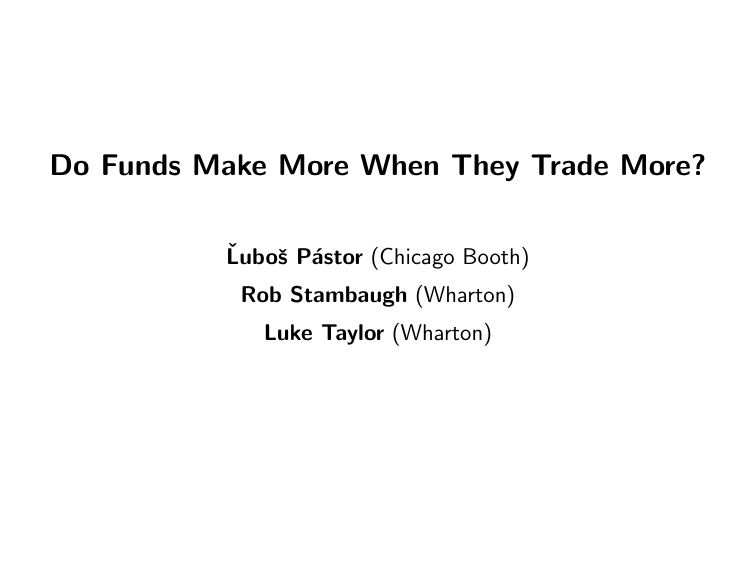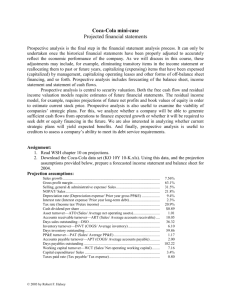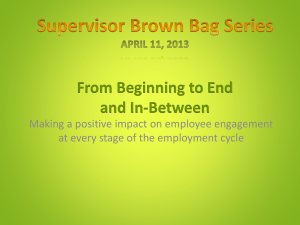Do Funds Make More When They Trade More? ˇ Luboˇ s P´
advertisement

Do Funds Make More When They Trade More? Ľuboš Pástor (Chicago Booth) Rob Stambaugh (Wharton) Luke Taylor (Wharton) Motivation Are active fund managers skilled? Active management: Lion’s share of mutual fund assets Idea: ◦ A fund trades more when it perceives better opportunities ◦ If the fund is skilled, perceived opportunities produce profits ⇒ A skilled fund should earn more after trading more Does higher trading activity predict better fund performance? Do funds know when it’s a good time to trade? Main Result Active mutual funds perform better after trading more heavily Positive turnover-performance relation: b > 0 in Ri,t = ai + b FundTurni,t−1 + i,t Ri,t : Fund i’s benchmark-adjusted gross return in month t FundTurni,t−1 : Fund i’s turnover for most recent 12-month period that ends before month t (turnover = min(buys,sells)/TNA) ai : Fund fixed effects ⇒ Focus on within-fund time variation Funds are skilled at exploiting time-varying profit opportunities A one-std-dev ↑ in turnover ⇔ 0.65 % per year ↑ in performance Other Results The positive turnover-performance relation is stronger for Small funds ⇒ Fund-level decreasing returns to scale High-fee funds ⇒ Greater skill earns higher fees Funds collectively trade more when mispricing is more likely Average turnover positively predicts fund performance More predictive power within similar funds Less if funds act in concert: Industry-level decreasing returns to scale Investment strategies exploiting the T-P relation are profitable Sharpe ratio of 0.79 per year ⇒ High economic significance Novel mapping between regressions and investment strategies Literature Are active fund managers skilled? Not enough to look at fund performance; performance 6= skill Gross vs. net fund returns Performance reflects skill but also scale (fund size, industry size); see Berk & Green (2004), Pástor & Stambaugh (2012), Berk & Binsbergen (2014), Pástor, Stambaugh, Taylor (2014), Stambaugh (2014) How does fund turnover relate to fund performance? Mixed evidence: Elton, Gruber, Das, Hlavka (1993), Carhart (1997), Wermers (2000), Dahlquist, Engström, Söderlind (2000), Chen, Jagadeesh, Wermers (2001), Edelen, Evans, Kadlec (2007) Carhart (1997) finds a negative relation All analyze a cross-sectional relation; we focus on the time-series Do more active funds perform better? Kacperczyk, Sialm, and Zheng (2005, 2008), Cremers and Petajisto (2009), Amihud and Goyenko (2013) Sample 3,126 active U.S. domestic equity mutual funds, 1979–2011 Data: Combine CRSP and Morningstar Check accuracy across databases (return, size, expense ratio) Exclude index funds, non-equity funds, international funds, industry funds, target-date funds, funds of funds, funds with size < $15 million Same sample as in Pástor, Taylor, and Stambaugh (2014) Builds on Berk and Binsbergen (2014) Sample 2000 1800 Has return Also has exp. ratio and benchmark data Also has FundSize 1600 Number of funds 1400 1200 1000 800 600 400 200 0 Jan 1980 Jan 1990 Jan 2000 Jan 2010 Turnover-Performance Relation Specif. 1: Cross-sectional & time-series relation Ri,t = a + b FundTurni,t−1 + i,t Specif. 2: Pure cross-sectional relation (month fixed effects) Ri,t = at + b FundTurni,t−1 + i,t Specif. 3: Pure time-series relation (fund fixed effects) Ri,t = ai + b FundTurni,t−1 + i,t Specif. 4: Month and fund fixed effects Turnover-Performance Relation Full-sample estimates of b b: Fund Fixed Effects Month Fixed Effects No Yes No 0.00040 (1.92) 0.00030 (1.61) Yes 0.00123 (6.63) 0.00106 (6.77) Role of Fund Size and Fees Does the turnover-performance relation vary across funds? Consider two fund characteristics: Fund size: Decreasing returns to scale Harder for a larger fund to exploit mispricing Fund fee (expense ratio): Proxy for skill More skilled managers should earn higher fees Turnover-Performance Relation in Size and Fee Categories Fund Size Fund Expense Ratio Medium Low All High All 0.00123 (6.63) 0.00170 (6.38) 0.00094 (4.62) 0.00058 (2.84) 0.00112 (4.06) Small 0.00186 (7.56) 0.00086 (3.74) 0.00043 (1.46) 0.00191 (5.91) 0.00126 (3.21) 0.00136 (2.22) 0.00240 (5.78) 0.00070 (2.70) -0.00015 (-0.47) 0.00054 (1.72) 0.00029 (0.94) 0.00046 (1.49) 0.00138 (3.11) 0.00097 (1.96) 0.00090 (1.59) 0.00143 (4.11) 0.00055 (0.81) 0.00255 (4.83) 0.00007 (0.18) 0.00145* (3.55) Medium Large Small–Large * Small/High – Large/Low High–Low Volatility of Fund Turnover Fund Size Fund Expense Ratio Medium Low High–Low All High All 0.438 0.508 0.419 0.378 0.130 (7.02) Small Medium Large 0.469 0.446 0.402 0.547 0.514 0.412 0.387 0.434 0.428 0.390 0.367 0.379 0.157 0.147 0.033 (5.57) (6.27) (1.28) Small–Large (t-statistic) 0.067 (3.69) 0.135 (5.01) -0.041 (-1.66) 0.011 (0.34) 0.168* (5.78) * Small/High – Large/Low (t-stat.) Average Fund Turnover Fund Size Fund Expense Ratio Medium Low High–Low All High All 0.848 0.979 0.839 0.730 0.249 (9.22) Small Medium Large 0.906 0.894 0.760 1.010 1.030 0.841 0.804 0.868 0.836 0.836 0.763 0.675 0.174 0.268 0.166 (3.87) (6.97) (4.16) Small–Large (t-statistic) 0.147 (5.67) 0.169 (4.17) -0.032 (-0.89) 0.161 (3.78) 0.335* (8.83) * Small/High – Large/Low (t-stat.) Autocorrelation of Fund Turnover Fund Size Fund Expense Ratio Medium Low All High High–Low (t-stat.) All 0.497 0.491 0.505 0.496 -0.005 (-0.16) Small Medium Large 0.425 0.474 0.590 0.470 0.484 0.563 0.340 0.502 0.608 0.351 0.405 0.589 0.119 0.079 -0.026 (1.98) (1.58) (-0.60) -0.165 (-5.13) -0.093 (-2.00) -0.268 (-5.13) -0.238 (-4.16) -0.119* (-2.76) Small–Large (t-statistic) * Small/High – Large/Low Average Benchmark-Adjusted Gross Fund Returns Fund Size Fund Expense Ratio Medium Low All High High–Low (t-stat.) All 0.0499 0.0879 0.0394 0.0228 0.0650 (3.54) Small Medium Large 0.0673 0.0580 0.0276 0.0938 0.1013 0.0537 0.0493 0.0557 0.0139 0.0342 0.0101 0.0259 0.0596 0.0912 0.0278 (2.32) (3.67) (1.05) Small–Large (t-statistic) 0.0397 (2.48) 0.0401 (1.35) 0.0354 (1.61) 0.0082 (0.41) 0.0679* (2.89) * Small/High – Large/Low All returns are in percent per month, 1979–2011 Average Benchmark-Adjusted Net Fund Returns Fund Size Fund Expense Ratio Medium Low All High High–Low (t-stat.) All -0.0534 -0.0552 -0.0596 -0.0455 -0.0097 (-0.53) Small Medium Large -0.0502 -0.0471 -0.0623 -0.0551 -0.0399 -0.0811 -0.0516 -0.0428 -0.0840 -0.0370 -0.0609 -0.0399 -0.0180 0.0210 -0.0412 (-0.70) (0.85) (-1.56) Small–Large (t-statistic) 0.0121 (0.75) 0.0260 (0.87) 0.0325 (1.48) 0.0029 (0.14) -0.0151* (-0.64) * Small/High – Large/Low All returns are in percent per month, 1979–2011 Role of Other Funds Is heavy trading by other funds good or bad for a given fund? Good: More mispricing Bad: More competition Industry-level decreasing returns to scale, as in Pástor and Stambaugh (2012), Pástor, Stambaugh, and Taylor (2014) Common component of fund trading: average turnover 95% correlated with 1st principal component of individual fund turnover Is average turnover higher when mispricing is more likely? Three proxies for mispricing: Sentiment (Baker and Wurgler, 2007) Volatility (Cross-sectional std dev of individual stock returns) Liquidity (Pástor and Stambaugh, 2003) 0.9 0.8 0.7 0.6 Jan 1980 Normalized value Average Turnover 1 Jan 1980 Jan 1990 Jan 2000 Jan 2010 Jan 2000 Jan 2010 Sentiment Volatility Liquidity Jan 1990 Is Average Turnover Related to Mispricing? Time-series regression, dependent variable: AvgTurnt Sentimentt 0.0531 (3.17) Volatilityt 0.0487 (4.65) 0.938 (7.23) Liquidityt 0.809 (7.98) -0.212 (-4.14) Business Cyclet -0.00334 (-0.66) Lagged Mkt. Returnt Time Trendt Observations R2 R 2 –R 2 (trend only) -0.138 (-4.58) 0.0171 (0.34) 0.000602 (5.21) 372 0.524 0.171 0.000400 (3.88) 382 0.542 0.189 0.000459 (3.44) 382 0.377 0.024 0.000523 (5.20) 372 0.677 0.324 What Helps Explain Fund Performance? Panel regression with fund fixed effects, dependent variable: Ri,t AvgTurnt−1 0.00741 (2.13) 0.00722 (2.04) 0.00873 (2.34) 0.0135 (2.77) 0.0299 (3.22) 0.0261 (2.55) -0.217 (-2.69) -0.277 (-2.93) -0.0266 (-2.42) 0.158 (2.55) 0.205 (2.83) 0.00101 (6.21) 0.00101 (6.20) 0.00100 (6.16) 0.00108 (6.47) -0.0218 (-4.26) -0.0361 (-3.97) -0.0309 (-3.78) -0.0156 (-2.28) AvgTurnt−1 × AvgCorrt−1 AvgCorrt−1 FundTurni,t−1 0.00107 (6.46) IndustrySizet−1 Sentimentt−1 0.00224 (3.38) Volatilityt−1 0.0118 (1.31) Liquidityt−1 -0.00333 (-0.92) 269056 Observations 309695 284800 284800 284800 284800 Commonality in Turnover Fund Size All Fund Expense Ratio High Medium Low A. Avg Correlation of FundTurn & AvgTurn All 0.131 0.119 0.139 0.135 Small Medium Large 0.114 0.123 0.151 0.085 0.138 0.150 0.135 0.123 0.157 0.146 0.104 0.148 B. Avg Correlation of FundTurn & OwnCellAvgTurn All 0.173 0.150 0.176 0.194 Small Medium Large 0.138 0.160 0.213 0.115 0.158 0.201 0.139 0.152 0.228 0.185 0.173 0.209 What Helps Explain Fund Performance? Panel regression with fund fixed effects, dependent variable: Ri,t OwnCellAvgTurni,t−1 0.00511 (4.16) 0.00397 (6.61) 0.00307 (5.72) 0.00386 (1.13) 0.00378 (1.09) 0.000938 (5.72) 310779 284800 -0.00361 (-0.91) 0.000978 (5.84) -0.00666 (-1.24) 0.00168 (2.93) 0.0160 (1.72) -0.00490 (-1.38) 269056 OwnCellAvgTurni,t−1 × AvgCorrt−1 AvgTurnt−1 FundTurni,t−1 IndustrySizet−1 Sentimentt−1 Volatilityt−1 Liquidityt−1 Observations 0.00582 (4.94) -0.0389 (-2.85) 0.00264 (0.56) 0.000983 (5.88) -0.0219 (-2.92) 0.00194 (3.17) 0.0127 (1.40) -0.00438 (-1.24) 269056 Investment Perspectives Consider two investment strategies: Timing strategy Cross-sectional strategy Different way to assess the economic significance of our regression evidence on the turnover-performance relation Equivalence between timing strategy and panel regression Timing Strategy Time-varying allocation between a fund and its benchmark For fund i and month t, invest wi,t−1 = FundTurni,t−1 dollars in fund i and 1 − wi,t−1 dollars in fund i’s benchmark Short the non-timing strategy that invests a constant w i dollars in fund i each month, where w i is the time-series average of wi,t Average benchmark-adjusted return for fund i: Ti 1 X (wi,t−1 − w i ) Ri,t Ti t=1 Invest one dollar in each fund’s timing strategy each month Equivalence Between Timing Strategy and Regression R: Timing strategy’s average return (dollar-weighted): Ti N X X 1 R = PN i=1 Ti (wi,t−1 − w i ) Ri,t i=1 t=1 b b: OLS estimate of the slope from our panel regression Ri,t = ai + b FundTurni,t−1 + i,t Mapping between the two: PN R =b b Ti σ bi2 Pi=1 N i=1 Ti ! where (.) is average variance of FundTurni,t Average Returns of Timing Strategy Fund Size All Fund Expense Ratio High Medium Low High–Low All 0.0235 (6.53) 0.0462 (6.49) 0.0183 (4.14) 0.0067 (2.19) 0.0395 (5.78) Small 0.0382 (6.45) 0.0218 (4.14) 0.0135 (3.04) 0.0541 (5.11) 0.0404 (3.46) 0.0411 (4.21) 0.0356 (4.76) 0.0173 (2.79) 0.0057 (0.87) 0.0074 (1.02) 0.0049 (0.98) 0.0074 (1.66) 0.0466 (3.68) 0.0355 (2.88) 0.0338 (3.67) 0.0247 (3.87) 0.0129 (0.99) 0.0299 (3.27) 0.0000 (0.00) 0.0467* (4.36) Medium Large Small–Large * Small/High – Large/Low All returns are in percent per month, 1979–2011 Economic Significance Average return of 0.0235% per month is deceptively small Long-short strategy’s volatility is only 0.11% per month When scaled to volatility of 20% per year, the strategy’s average return rises to 1.3% per month, or 15.9% per year! The strategy’s annualized Sharpe ratio: 0.79 For comparison, here are the Sharpe ratios in the 1979-2011 period for MKT: 0.43, SMB: 0.20, HML: 0.35, MOM: 0.51 Turnover-performance relation is highly economically significant Cross-Sectional Strategy At beginning of each month t, sort funds into terciles based on 1 t−1 FundTurni,t−1 Pt−1 s=1 FundTurni,s Record returns in month t, rebalance monthly Strategy is not directly linked to our regression, but is feasible Average Gross Returns of Cross-Sectional Strategy Sample months Full Sample High Sentiment Low Sentiment High–Low FundTurni,t−1 /trailing-average turnover Low Medium High High – Low 0.0102 (0.31) 0.0456 (0.85) -0.0300 (-0.74) 0.0755 (1.13) 0.0498 (1.42) 0.1003 (1.69) 0.0033 (0.09) 0.0970 (1.38) 0.0626 (1.80) 0.1329 (2.25) -0.0083 (-0.23) 0.1412 (2.05) 0.0524 (2.58) 0.0874 (2.71) 0.0217 (0.87) 0.0656 (1.61) F -test p-value 0.033 0.028 0.249 Average Net Returns of Cross-Sectional Strategy Sample months Full Sample High Sentiment Low Sentiment High–Low FundTurni,t−1 /trailing-average turnover Low Medium High High – Low -0.0857 (-2.58) -0.0471 (-0.88) -0.1294 (-3.19) 0.0822 (1.23) -0.0440 (-1.25) 0.0094 (0.16) -0.0937 (-2.51) 0.1031 (1.47) -0.0320 (-0.92) 0.0442 (0.75) -0.1095 (-3.04) 0.1537 (2.23) 0.0537 (2.64) 0.0914 (2.82) 0.0199 (0.80) 0.0715 (1.75) F -test p-value 0.027 0.020 0.184 Conclusions Active mutual funds perform better after trading more heavily Novel evidence of skill This positive turnover-performance relation is stronger for Small funds ⇒ Fund-level decreasing returns to scale High-fee funds ⇒ Greater skill earns higher fees Funds collectively trade more when mispricing is more likely Average turnover positively predicts fund performance More predictive power within similar funds Less if funds act in concert: Industry-level decreasing returns to scale Investment strategies support economic significance of our results





